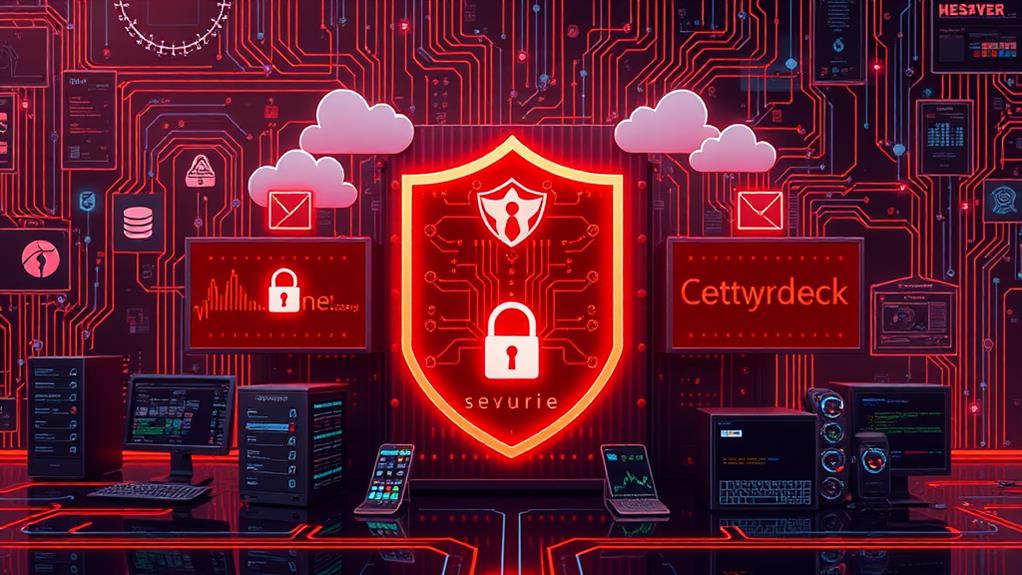Understanding the financial aspects of maintaining a small website is vital for any business or individual venturing into the online domain. From domain registration fees to web hosting expenses, security measures, and ongoing maintenance, the costs can quickly accumulate. However, the question remains: how much does it really cost to keep a small website operational and competitive in today's digital terrain? Let's investigate the breakdown of these expenses to gain a thorough insight into what it takes to sustain a successful online presence.
Key Takeaways
- Domain renewal fees vary by registrar and extension, budget accordingly.
- Consider domain privacy protection to reduce spam and keep personal information private.
- Hosting costs vary; shared hosting is budget-friendly, dedicated hosting offers more resources.
- SSL certificate renewal is crucial for website security and user data protection.
- Maintenance expenses cover updates, security patches, backups, and monitoring for a small website.
Domain Name Registration
Securing a domain name is the initial step in establishing a digital presence for a small website. When registering a domain, it is important to take into account renewal fees and domain privacy to guarantee the smooth operation and protection of your online identity.
Renewal fees are recurring charges that must be paid to keep your domain name active. These fees vary depending on the domain registrar and the extension chosen (.com, .org, .net, etc.). It is vital to budget for these costs to avoid any disruptions in your website's availability.
Additionally, domain privacy is a significant factor to think about when registering a domain. By choosing domain privacy protection, your personal information, such as your name, address, and contact details, is kept private and not publicly accessible through the WHOIS database. While this service may come at an additional cost, it helps safeguard your privacy and reduces the risk of spam or unwanted solicitations.
When planning the cost of running a small website, factoring in renewal fees and domain privacy is essential for a seamless and secure online presence.
Web Hosting Fees
When considering the cost of running a small website, one vital aspect to examine is the web hosting fees involved. Grasping the different types of hosting options available, such as shared hosting, VPS hosting, and dedicated hosting, is essential for making an informed decision. Additionally, conducting a cost comparison between various hosting providers can help determine the most cost-effective solution for your specific website needs.
Hosting Types
How do you select the right hosting kind for your small website? When examining hosting varieties, comprehending server choices and performance factors is essential.
Shared hosting is cost-efficient, but resources are shared among multiple websites, potentially impacting performance.
Virtual Private Servers (VPS) offer dedicated resources within a shared environment, providing improved performance.
Dedicated servers offer exclusive use of resources, ideal for high-traffic websites needing maximum performance.
Cloud hosting offers scalability and flexibility by utilizing multiple virtual servers, adjusting resources based on demand.
Factors such as website traffic, storage requirements, and budget influence the choice of hosting kind. Consider the level of control, customization, and technical knowledge required when selecting a hosting kind.
Evaluating uptime guarantees, security features, and customer support is vital to ensure a reliable hosting service for your small website.
Choose a hosting kind that aligns with your website's requirements and growth plans.
Cost Comparison
Moving from grasping hosting types to evaluating the financial aspect, the cost comparison of web hosting fees is a significant consideration when establishing a small website. Cost effectiveness is vital when choosing a hosting plan that aligns with your budget management goals.
Various hosting providers offer a range of packages at different price points, each with its own set of features and limitations. Shared hosting is often the most budget-friendly option, where multiple websites share resources on a single server, keeping costs low. VPS hosting provides a more scalable solution, with dedicated resources for your website at a higher price. Dedicated hosting offers the highest level of performance and control but comes with a premium cost. Cloud hosting is another option that allows flexibility and scalability, but costs can vary based on usage.
Understanding the cost impacts of different hosting types is essential for effective budget management and ensuring your small website runs smoothly without overspending.
Security & SSL Certificates
Securing a small website is essential in today's digital environment, where cyber threats are on the rise and data breaches can have severe consequences.
One important aspect of website security is SSL implementation. SSL (Secure Sockets Layer) certificates encrypt data exchanged between a user's browser and the website server, ensuring that sensitive information remains confidential and secure. These certificates use various encryption methods to safeguard data from potential cyber threats.
Regular SSL renewal is necessary to maintain the security of a small website. Over time, SSL certificates expire, and renewing them is crucial to continue providing a secure connection for users. Failure to renew SSL certificates can lead to security vulnerabilities, potentially exposing the website to cyber attacks.
Investing in robust security measures, such as SSL certificates and staying updated on the latest encryption methods, is essential for small website owners to protect their data and maintain the trust of their users in an increasingly digital world.
Website Design & Development
When considering the cost of running a small website, it is crucial to break down the design expenses, estimate the development time required, and overview the maintenance costs involved.
Design costs include aspects such as graphic design, user interface design, and branding elements.
Development time estimation involves planning the programming, testing, and implementation phases to project the resources required.
Additionally, maintenance expenses cover ongoing updates, bug fixes, and content management to guarantee the website's functionality and relevance.
Design Costs Breakdown
With regards to the cost breakdown of running a small website, one of the significant expenses to take into account is the design and development phase. Design costs include various elements such as graphic design, layout creation, typography selection, color schemes, and overall aesthetics in line with current design trends. Investing in a visually appealing website is important as it not only attracts visitors but also improves user experience, positively impacting engagement and conversion rates.
When considering design costs, it's crucial to prioritize user experience (UX) to make sure that visitors can easily navigate the website, find information intuitively, and have a pleasant interaction.
This involves creating a seamless flow from one page to another, optimizing for different devices, and incorporating elements that improve usability.
Development Time Estimation
For the estimation of development time in website design and development, a careful approach is necessary to guarantee a thorough grasp of the tasks involved. The project scope, budgeting, resource allocation, and timeline estimation are crucial elements in determining the development time required for a website.
Understanding the project scope is vital as it defines the features, functionalities, and intricacy involved in the development process. Budgeting plays a notable role in determining the resources that can be allocated to the project, which directly impacts the development time. Efficient resource allocation ensures that the right personnel with the necessary skills are assigned to the project, optimizing productivity and reducing development time.
Timeline estimation involves breaking down the project into smaller tasks, setting milestones, and establishing a realistic timeframe for completion. By meticulously considering these aspects, developers can provide accurate estimates of the time needed to complete the website development, guaranteeing a smooth and efficient process.
Maintenance Expenses Overview
Maintenance expenses in website design and development include the ongoing costs associated with upholding the functionality, security, and performance of a website post-launch. When considering maintenance budgeting, it is crucial to account for regular updates, security patches, backups, and monitoring to guarantee the website operates smoothly. Investing in cost-effective updates can help in optimizing performance without breaking the bank.
| Maintenance Expenses | Description |
|---|---|
| Regular Updates | Includes updating plugins, themes, and content to keep the website secure and functioning properly. |
| Security Patches | Implementing patches to address vulnerabilities and protect the site from cyber threats. |
| Backups | Regularly backing up website data to prevent loss in case of technical issues or cyberattacks. |
Content Management System (CMS)
A Content Management System (CMS) is an essential tool for organizing, creating, and managing digital content on a small website. When contemplating the cost of running a small website, the CMS plays a pivotal role in maintaining an effective online presence. Here are some key aspects to ponder regarding CMS for a small website:
- CMS Customization: Customizing the CMS to suit the specific needs and branding of the website can incur additional expenses. This may involve design modifications, feature integrations, or creating unique templates.
- CMS Training: Providing training for website administrators on how to effectively use the CMS can lead to smoother operations and content management. Training sessions may be conducted by professionals or through online resources.
- Regular Updates: Ensuring the CMS is regularly refreshed with the latest security patches and features is vital to keep the website running smoothly and securely.
- Technical Support: Having access to reliable technical assistance for the CMS can help troubleshoot issues quickly and maintain website functionality.
Plugins and Integrations
When considering the functionality and improvement of a small website, the integration of plugins and connections becomes an important aspect of its digital ecosystem. Plugin customization allows you to tailor your website's features to suit your specific needs. Whether it's adding a contact form, social media connection, or boosting SEO capabilities, plugins play a significant role in expanding the functionality of your site. However, it's important to choose reliable plugins to avoid security risks and performance issues.
Connection optimization ensures that different tools and software work seamlessly together to provide a smooth user experience. Integrating e-commerce platforms, payment gateways, or analytics tools can improve the overall performance of your website. Regularly updating and maintaining these connections is key to ensuring they continue to function effectively.
Investing in plugin customization and connection optimization may incur additional costs, but the benefits in terms of improved functionality and user experience are often worth it. It's important to carefully evaluate the necessity and impact of each plugin or connection to ensure they align with your website goals and budget.
Regular Backups
Given the complex network of plugins and integrations that improve the functionality of a small website, it becomes crucial to safeguard your digital assets through regular backups. Guaranteeing the continuity of your website involves implementing a robust backup strategy. Here are key considerations for regular backups:
- Backup Frequency: Determine how often you need to back up your website. Depending on how frequently your content is updated, consider daily, weekly, or monthly backups to prevent data loss.
- Backup Storage: Choose a secure and reliable storage solution for your backups. Cloud storage services or dedicated backup servers are convenient options to store your website backups safely.
- Automation: Implement automated backup solutions to streamline the process and assure backups are performed consistently without manual intervention.
- Retention Policy: Define a retention policy outlining how long backups should be kept. Regularly review and adjust this policy to balance storage costs with the need for historical backups.
Technical Support and Maintenance
Enhancing the best functioning and longevity of a small website requires vigilant attention to technical support and maintenance. Two vital aspects of this are server management and software updates. Proper server management involves monitoring the server's performance, security, and capacity to guarantee the website runs smoothly. It also includes tasks like troubleshooting server issues, optimizing server configurations, and ensuring data backups are regularly performed to prevent data loss.
The table below illustrates the importance of software updates in maintaining a small website:
| Software Updates | Description | Frequency |
|---|---|---|
| Security Patches | Critical updates that fix vulnerabilities and protect against cyber threats | Monthly |
| Feature Upgrades | Improvements and new capabilities to boost website functionality | Quarterly |
| Bug Fixes | Corrections for software issues and errors to maintain smooth operation | As needed |
Marketing and SEO Costs
To ensure the visibility and success of a small website in the digital realm, allocating resources for Marketing and SEO Costs is necessary. Here are some key aspects to keep in mind in this regard:
- Social Media: Utilizing social media platforms such as Facebook, Twitter, Instagram, and LinkedIn can help drive traffic to your website. Crafting engaging posts, running targeted ads, and interacting with your audience can improve your online presence.
- Email Marketing: Establishing an email list and sending out newsletters or promotional emails can be a cost-effective way to connect with your audience. Personalized content and targeted campaigns can lead to higher conversion rates.
- SEO Strategy: Investing in Search Engine Optimization (SEO) is essential for enhancing your website's visibility on search engines like Google. This includes keyword research, optimizing meta tags, creating quality content, and building backlinks.
- Paid Advertising: Take into account setting aside a budget for pay-per-click (PPC) advertising campaigns on platforms like Google Ads or social media ads to attract targeted traffic to your website and boost conversions.
Frequently Asked Questions
What Are the Average Costs for Website Updates and Maintenance?
When considering website updates and maintenance costs, factors such as content management and security updates play pivotal roles. Content management expenses can vary depending on the complexity of updates needed, ranging from simple text changes to more detailed design alterations.
Security updates are essential to protect against cyber threats and maintain data integrity, with costs varying based on the level of protection required. Regular maintenance helps keep a website operational and secure.
How Can I Optimize My Website for Mobile Devices?
To optimize your website for mobile devices, focus on mobile responsiveness for improved user experience. Guarantee your site loads quickly, has a clean design, and is easy to navigate on mobile devices. Implement mobile SEO strategies to boost search rankings, such as using responsive design, optimizing images, and prioritizing mobile-friendly content.
Regularly test your website on various mobile devices to secure a seamless experience for all users.
Are There Additional Fees for E-Commerce Functionality?
When implementing e-commerce functionality on a website, additional fees may arise for payment gateways and SSL certificates. Payment gateways help secure online transactions by connecting the website to financial networks. SSL certificates guarantee data encryption for customer information protection. These essential components for e-commerce operation often involve costs from third-party providers. Grasping and budgeting for these fees are vital for a smooth and secure online shopping experience.
Do I Need to Budget for Website Speed Optimization?
When considering website speed optimization, budgeting is essential for a seamless user experience. This entails investing in efficient hosting services, image optimization, and caching mechanisms. A fast-loading site improves user engagement, boosts SEO rankings, and supports effective marketing strategies.
Moreover, it aligns with content creation and social media efforts, ensuring that your online presence remains competitive and engaging. Prioritizing website speed optimization is crucial for a successful digital presence.
What Are the Costs Associated With Website Analytics and Tracking?
Website analytics and tracking play a pivotal role in comprehending user behavior and optimizing a site's performance. Costs associated with these tools depend on the selected platform, features needed, and the size of the website.
Implementing SEO strategies and conversion tracking are fundamental components of effective analytics, helping to boost visibility and drive conversions. Investing in these tools is vital for businesses seeking to make data-driven decisions and improve their online presence.
Conclusion
In conclusion, maintaining a small website involves various ongoing expenses such as domain registration, web hosting, security measures, website design, CMS customization, and marketing investments. Like tending to a garden, nurturing a website requires careful attention to detail, regular maintenance, and strategic planning to ensure its development and success in the digital environment. Just as a gardener tends to their plants with care, website owners must invest in the necessary resources to keep their online presence thriving.








